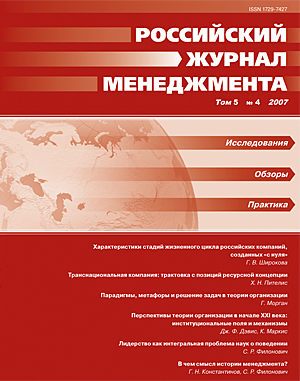Life-Cycle Stage Characteristics of the Russian Companies
Abstract
The paper uses the concept of life cycle which is based on the comparison between organizations and living beings and attempts to explain the reasons of organizational change that take place in the companies over time. Based on the generalized fivestage model, the paper presents the results of comparative analysis for ten organizational life cycle models. It discusses the results of empirical life cycle study that was conducted for the Russian companies in St. Petersburg between September and March, 2006. The main objective of the research was to study the properties of life cycle development specific for the Russian companies of different origin: created from the scratch, privatized or funded by foreign investments. Further directions for the development of organizational life cycle theory are suggested. Based on the generalized fivestage model, the paper presents the results of comparative analysis for ten organizational life cycle models. It discusses the results of empirical life cycle study that was conducted for the Russian companies in St. Petersburg.
Downloads
References
REFERENCES IN LATIN ALPHABET
Downloads
Published
How to Cite
Issue
Section
License
Articles of the Russian Management Journal are open access distributed under the terms of the License Agreement with Saint Petersburg State University, which permits to the authors unrestricted distribution and self-archiving free of charge.





